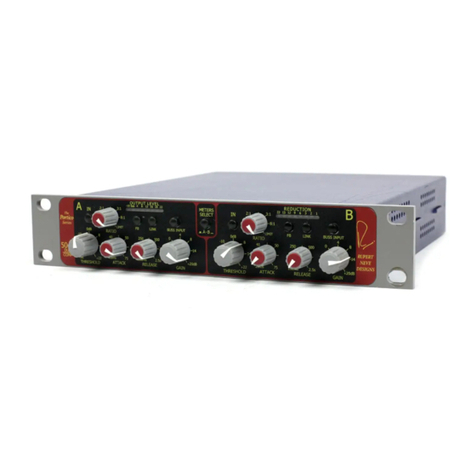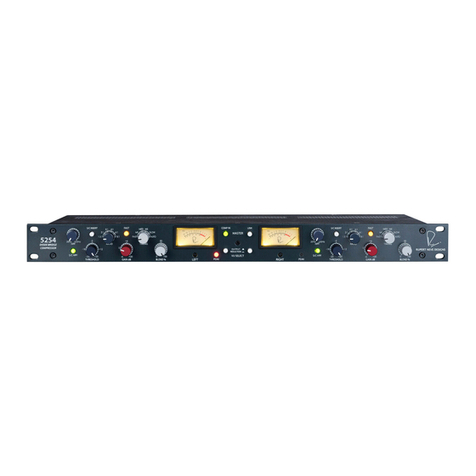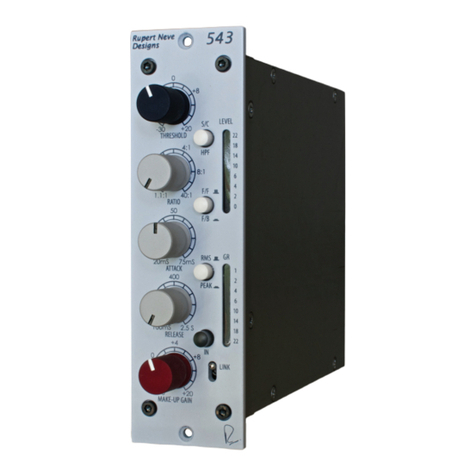
2
Thank you for your purchase of the RNDI Active Transformer Direct Interface. Everyone at Rupert Neve
Designs hopes you enjoy using this tool as much as we have enjoyed designing and building it.
Front / Back Panel
RNDI Overview
The RNDI is designed to deliver instrument (electric guitar, bass, keyboard, piezo pickup, etc.) and speaker
feed direct injection with unprecedented sound quality. The class-A & discrete circuit topology found
in the RNDI is based around Mr. Rupert Neve’s custom transformers, and allows for outstanding sonic
performance and superior noise rejection. The RNDI can handle extremely high input levels without
clipping (+21dBu on instrument & 41.5dBu on speaker), and the transformer coupled output has a very
low output impedance of 40 Ohms, which is capable of driving long lines with minimal loss. The chassis
of the RNDI is a formed steel clamshell designed to hold up to the rigors of use on stage or in the studio.
Usage Notes
Power for the RNDI is supplied by standard 48V phantom power on the XLR output connection, and is
indicated by a front panel LED. Try to avoid placing the RNDI close to strong electro-magnetic radiators
like power ampliers, as some noise can still be induced on the transformers through the RNDI’s steel
shielding. To minimize ground loop hum, the full signal chain should ideally be on a single isolated
circuit. If you are experiencing a hum on the RNDI output or amplier, experiment with switching the
ground lift on the RNDI and ground lifts on other components in the chain. If that doesn’t work, try
removing certain modules or powering off other devices on the same power circuit to minimize the hum.
In an instrument conguration, the DI converts the impedance of the instrument signal, balances the signal
(if unbalanced), provides a buffered output stage to send to a separate mic preamp, and optionally sends
the THRU connection to the amp input. To get the best performance out of your RNDI, we recommend
you use the best available cables and mic preamps, and output the maximum level from your instrument.
In a speaker feed conguration, the DI is used post power amplier to capture the tone of the preamp and
power amp. Be sure to switch the RNDI input level to speaker and connect the amplier and speaker
BEFORE turning the amplier on. With tube power amps, THE SPEAKER MUST BE CONNECTED to the
THRU connection to provide a load for the amplier. Solid state amps can generally be run without a
speaker connected. See the diagrams below for standard connection examples.
RNDI: Active Transformer Direct Interface
1/4” Input
Hi-Z Unbalanced Input
2.2M Ω : Instrument
200KΩ : Speaker
1/4” Thru
Parallel 1/4” Port
used to send signal
to the amp or speaker
Input Level
Selects speaker or
instrument level
Max input +21dBu Inst.
or +41.5dBu Speaker
SPEAKER
INPUT LEVEL
INSTRUMENT
48V
POWER
IN THRU
Rupert Neve Designs
Ground Lift
Isolates the XLR pin 1
from the instrument
input ground
Output
Transformer balanced
XLR Output. Impedance
less than 40Ω
LIFT
GND
OUTPUT
Active Transformer
Direct Interface
Rupert Neve Designs, LLC
RNDI
To RNDI In
SPEAKER
INPUT LEVEL
INSTRUMENT
48V
POWER
IN THRU
Rupert Neve Designs
To Amp In XLR Output on Back:
To Mic Pre
36
30
24
18
12
60dB 66
60
54
48
42
20Hz 250Hz
100
MIN MAX
TEXTURE
0dB
-6 +6
TRIM
GAIN
POWER
SILK
48V
HPF
HPF
Rupert Neve
Designs 511
MICPRE
+SILK
22
20
18
14
10
4
-2
-10
LEVEL
Powered Amp Out
To RNDI In
SPEAKER
INPUT LEVEL
INSTRUMENT
48V
POWER
IN THRU
Rupert Neve Designs
To Amp In
XLR Output
To Mic Pre
36
30
24
18
12
60dB 66
60
54
48
42
20Hz 250Hz
100
MIN MAX
TEXTURE
0dB
-6 +6
TRIM
GAIN
POWER
SILK
48V
HPF
HPF
Rupert Neve
Designs 511
MICPRE
+SILK
LEVEL
Thru Out
To Speaker In
Instrument Configuration (Instrument Selected) Speaker Feed Configuration (Speaker Selected)
























